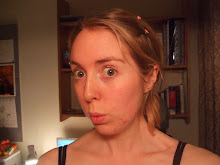 Above - the bath filled with soil and planted with cacti.
Above - the bath filled with soil and planted with cacti.What an excellent day for sightseeing in Dresden. It did nothing but rain – from the moment I opened my eyes in the morning to the moment I closed them at night. So all my photos of Dresden are dreary, and complete with a grey backdrop of clouds and streaks of rain. I spent the morning and the first part of the afternoon paddling around Dresden. It’s not a big city. According to my guide book it has a population of just under 500 000. It’s a beautiful city with a Baroque centre, so originally called The Old Town, but there are also examples of Renaissance and Neo-Classical architecture. Much of Dresden was destroyed during the Second World War but it is slowly being rebuilt. Some of it has already been rebuilt – the Frauenkirche, for example, was destroyed during the 1945 bombing of the city but some pieces were collected and kept in storage and later put back together. The Residenzschloss Palace is also being rebuilt but, unlike the Frauenkirche, is yet to be finished. It was originally built between the 12th and 19th centuries and exhibits architecture from the Renaissance, Neo-Classical, Baroque and Romantic eras. It is also home to the famous crown jewels which are among some of Europe’s finest. One of the things that has impressed me most in Dresden was the street long mural of the procession of Dukes showing all of the Saxon rulers from 1123 to 1904. It’s made up of 24 000 ceramic tiles and is 102m long and 7m high. I also saw the world famous (apparently, although to be honest I’d never heard of it before) Semper Opera House and also the Zwinger which houses the art gallery of Old Masters which is home to Rafael’s ‘Sistine Madonna’. I also saw the Kunsthof Passage which is quite near to the hostel and is made up of four yards – light, metamorphosis, fable animals and the elements and is home to some interestingly painted buildings as well as individual boutiques. I walked the length of the Alaunstraße which gets its name from the craft of boiling Alaun – a salt used in dye works. I also walked the length of the Hauptstraße which led to the bridge over the River Elbe. I saw the guilded statue of August the Strong dating from 1736 and also, at the Albertplatz, two huge fountains and the ‘Noodle Tower’ representing how GDR city planners wanted the city to look but, fortunately, political change came round before the old houses could be pulled down. After paddling around the city with the rain showing no signs of stopping I decided to buy my lunch and head back to the hostel where I stayed for the rest of the day. So, Dresden is an ‘ornate’ city with some amazing architecture. Even though most of it was destroyed in the 1945 air raids it still manages to impress as most of it has been restored. Other areas however, have been redeveloped rather than restored – the Prager Straße, for example, retains none of its original beauty even though it remains one of the city’s main shopping streets. The once gigantic statue of Lenin was however removed after German reunification. Other parts of the city are still under construction but, despite the violent history and reconstruction works, Dresden remains home to a truly impressive collection of architecture. Well worth a visit.


